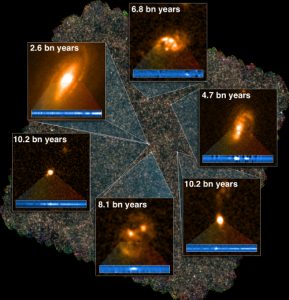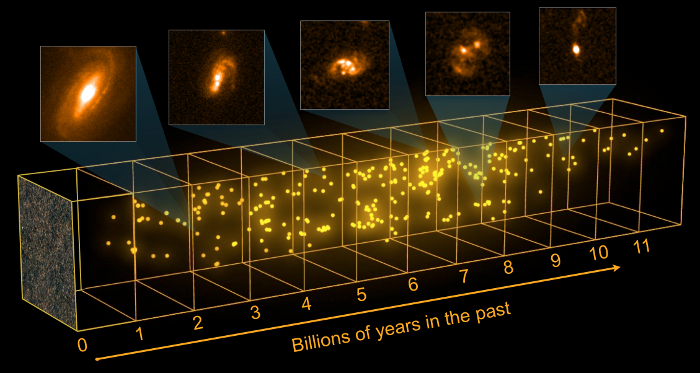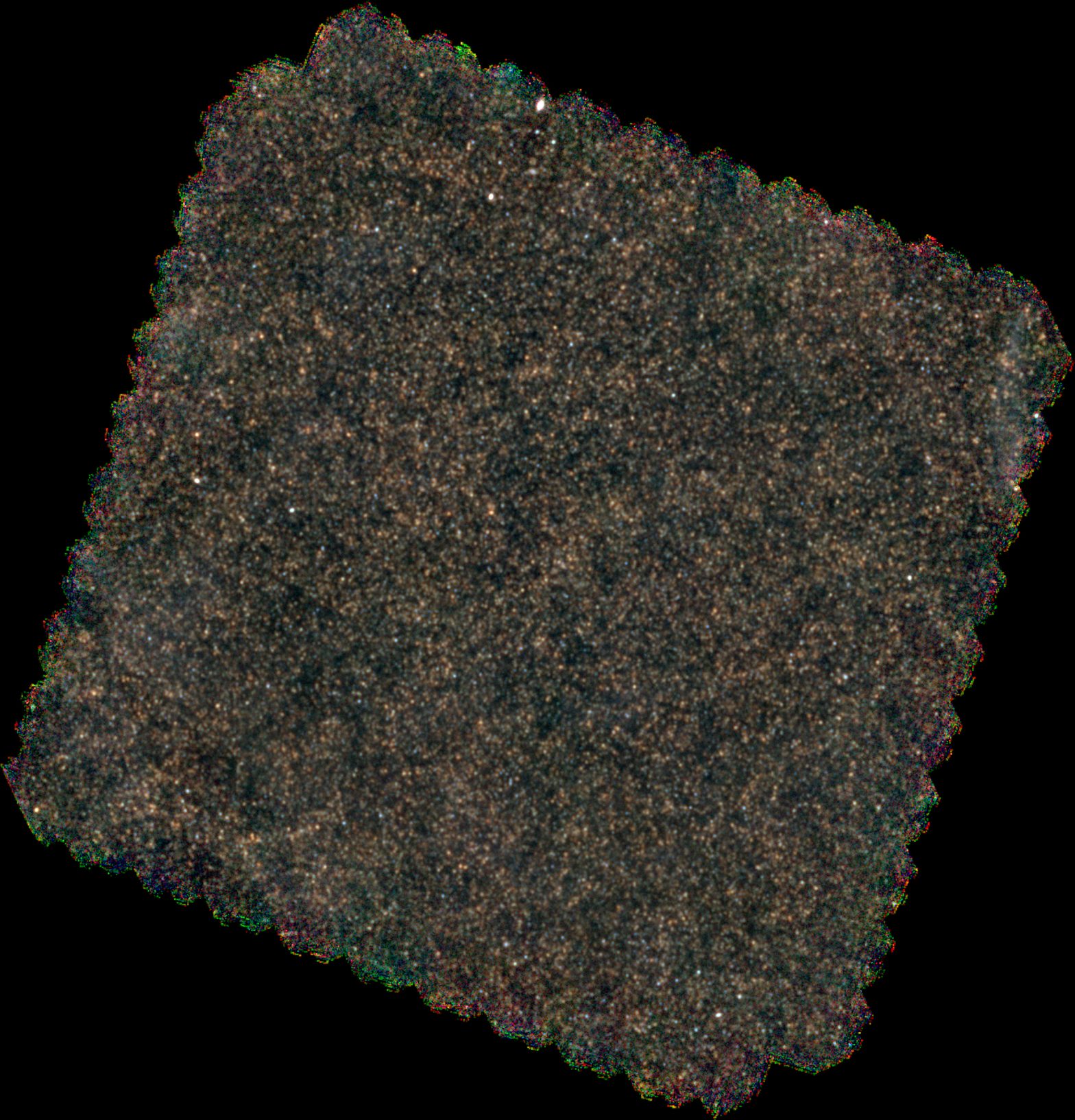| Basic Information | |
| What is this? | A region of the sky containing thousands of galaxies, some of which are forming stars at incredibly fast raites |
| Where is it in the sky? | In the constellation of Sextans |
| How big is it? | The image covers an area of sky with the same width a four full Moons |
| How far away is it? | The most distant galaxies are so far away they are seen as they were when the Universe was only 1-3 billion years old |
| What do the colours represent? | The redder galaxies are either more distant or contain colder dust – observations with the Keck telescope are required to determine which. |
Downloads
See this object in:
By combining the observing powers of Herschel with the ground-based Keck telescopes, astronomers have characterised hundreds of previously unseen “starburst galaxies”, revealing extraordinary high star-formation rates across the history of the Universe. These starburst galaxies give birth to stars at an incredible rate, equivalent to forming hundreds of Sun’s per year, with each “starbust” being a short-lived but intense events.
By comparison, our own Milky Way Galaxy on average produces the equivalent of only one Sun-like star per year. Starburst galaxies generate so much starlight that they should outshine our Galaxy hundreds to thousands of times over, but the enormous quantities of gas fuelling them also contain vast amounts of dust as a result of the frantic star formation.
The dust absorbs much of the visible light, meaning that many of them look quite insignificant in that part of the spectrum, and are hard to pick out from all the other galaxies around. However, the dust is warmed by the surrounding hot stars and re-emits the energy at far-infrared wavelengths. Herschel allows astronomers to measure the temperature and brightness of thousands of dusty galaxies, and from there calculate their star-formation rate.
“Starburst galaxies are the brightest galaxies in the Universe and contribute significantly to cosmic star formation, so it’s important to study them in detail and understand their properties,” says Dr Caitlin Casey of the University of Hawai‘i, lead author of these studies.
“Some of the galaxies found in this new survey have star-formation rates equivalent to the birth of several thousand solar-mass stars per year, constituting some of the brightest infrared galaxies yet discovered.”

But these images were not enough, and to understand how star formation has changed over the Universe’s 13.7 billion year history, the distances to the galaxies were also needed. Dr Casey’s team used the twin 10-metre W.M. Keck telescopes on Mauna Kea, Hawai‘i, and obtained the distances to 767 of the starburst galaxies picked out from the Herschel observations. The galaxies were in a number of regions around the sky, including the “COSMOS” field shown here.
The light from these distant galaxies has been stretched by the expansion of the Universe – a phenomena known as redshift – and these redshifts provide astronomers with a measure of how long the light from each galaxy has been travelling across the Universe. In turn, this indicates when in cosmic history the light from each galaxy was emitted.
For most of the galaxies it was found that the light has been travelling towards us for 10 billion years or less. But a small fraction – about 5% – of the galaxies are so distant that the light we detect from them was emitted when the Universe was only 1–3 billion years old.
“The Herschel data tell us how fiercely and prolifically these galaxies are producing stars,” says Prof Seb Oliver from University of Sussex, and lead scientist for the HerMES Key Programme, within which the data have been collected. “The time scales in question are so vast on a human scale, that we simply cannot watch galaxies change. Thus the only way to study galaxy evolution is to compare censuses of galaxies at different times. That is why these large samples are so important.”
How such large numbers of starburst galaxies formed during the first few billions of years of the Universe’s existence poses a vital problem for galaxy formation and evolution studies. One leading theory proposes that collision between young galaxies could have sparked these intense, short-lived phases of star formation. Another theory speculates that when the Universe was young, individual galaxies had much more gas available to them to feed from, enabling higher rates of star formation without the need of collisions. “It’s a hotly debated topic that requires details on the shape and rotation of the galaxies before it can be resolved,” adds Dr Casey.
“Before Herschel, the largest similar survey of distant starbursts involved only 73 galaxies – we’ve improved on that by over a factor of ten in this combined survey with Keck to determine the characteristics of this important galaxy population,” adds Göran Pilbratt, ESA’s Herschel project scientist.

Detailed Information
HerMES
- Casey et al. (2012) Astrophysical Journal 761, 139 “A redshift survey of Herschel far-infrared selected starbursts and implications for obscured star formation”
- Casey et al. (2012) Astrophysical Journal 761, 140 “A population of z>2 far-infrared Herschel-SPIRE selected starbursts”
- Herschel and Keck take census of the invisible Universe (ESA Portal)
- New galaxy census highlights importance of starbursts (ESA Science & Technology website)

